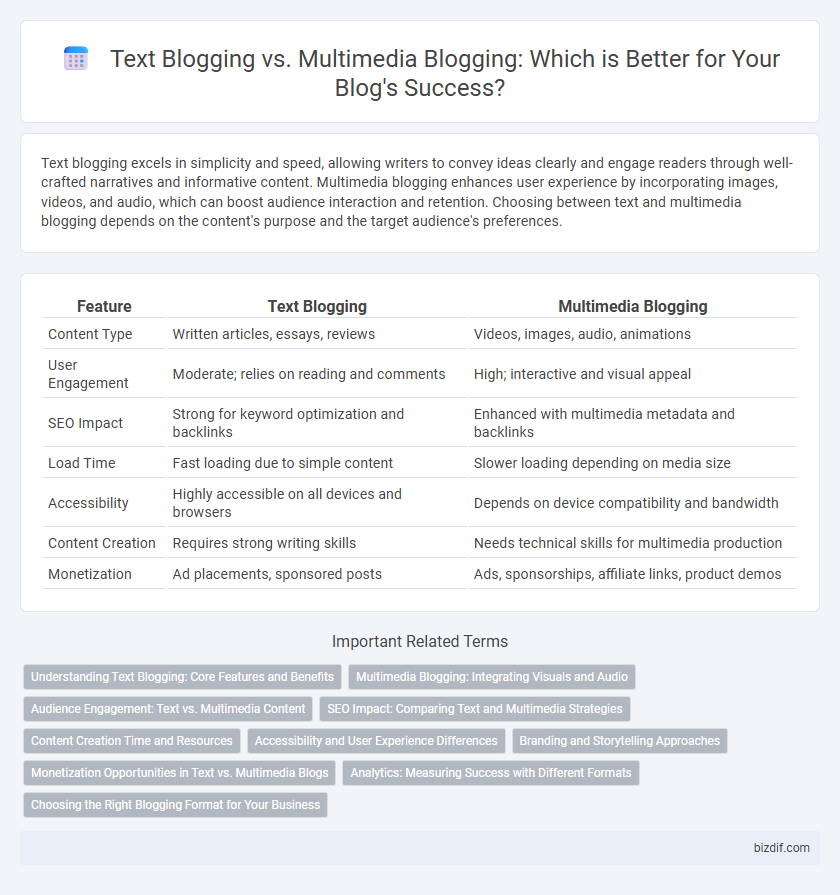Text blogging excels in simplicity and speed, allowing writers to convey ideas clearly and engage readers through well-crafted narratives and informative content. Multimedia blogging enhances user experience by incorporating images, videos, and audio, which can boost audience interaction and retention. Choosing between text and multimedia blogging depends on the content's purpose and the target audience's preferences.
Table of Comparison
| Feature | Text Blogging | Multimedia Blogging |
|---|---|---|
| Content Type | Written articles, essays, reviews | Videos, images, audio, animations |
| User Engagement | Moderate; relies on reading and comments | High; interactive and visual appeal |
| SEO Impact | Strong for keyword optimization and backlinks | Enhanced with multimedia metadata and backlinks |
| Load Time | Fast loading due to simple content | Slower loading depending on media size |
| Accessibility | Highly accessible on all devices and browsers | Depends on device compatibility and bandwidth |
| Content Creation | Requires strong writing skills | Needs technical skills for multimedia production |
| Monetization | Ad placements, sponsored posts | Ads, sponsorships, affiliate links, product demos |
Understanding Text Blogging: Core Features and Benefits
Text blogging offers a streamlined platform for expressive content, emphasizing clarity through well-structured articles, compelling narratives, and SEO-friendly keywords that boost organic reach. Core features include simple content management systems, easily editable formats, and compatibility with search engines, making it ideal for storytelling, tutorials, and in-depth analysis. Benefits encompass faster loading times, lower data usage, and enhanced accessibility, ensuring broad audience engagement across diverse devices and connection speeds.
Multimedia Blogging: Integrating Visuals and Audio
Multimedia blogging enhances audience engagement by integrating visuals such as images, videos, and infographics alongside audio elements like podcasts and voiceovers. This approach leverages human sensory processing, increasing content retention and emotional connection compared to traditional text blogging. Platforms supporting multimedia content, including WordPress and Medium, provide tools to seamlessly incorporate diverse media types, optimizing user experience and SEO performance.
Audience Engagement: Text vs. Multimedia Content
Text blogging offers deep, focused engagement through detailed narratives and well-crafted arguments that appeal to readers seeking in-depth information. Multimedia blogging combines videos, images, and audio to capture attention quickly and cater to diverse consumption preferences, enhancing interaction on social platforms. Studies show multimedia content increases user retention by up to 80%, while text content fosters longer reading sessions and stronger comprehension.
SEO Impact: Comparing Text and Multimedia Strategies
Text blogging enhances SEO through keyword-rich content that improves search engine indexing and boosts organic traffic. Multimedia blogging, incorporating images, videos, and infographics, increases user engagement and dwell time, signaling quality to search algorithms. Combining both strategies optimizes SEO by balancing content depth with interactive elements for superior search ranking performance.
Content Creation Time and Resources
Text blogging often requires less content creation time and minimal resources, as it primarily involves writing and basic editing tools. Multimedia blogging demands more extensive resources, including video production equipment, graphic design software, and longer editing processes that increase overall content creation time. Efficient planning and resource allocation are crucial to managing the time-intensive nature of multimedia content compared to text-based blogs.
Accessibility and User Experience Differences
Text blogging offers superior accessibility with faster loading times and compatibility across all devices, benefiting users with limited bandwidth or screen readers. Multimedia blogging enhances user experience by providing interactive elements like videos and images, which increase engagement but may pose challenges for users with slower connections or cognitive impairments. Optimizing multimedia content with alt text and captions ensures a more inclusive experience while maintaining the richness of visual storytelling.
Branding and Storytelling Approaches
Text blogging emphasizes detailed narrative and in-depth storytelling, enhancing brand voice through rich, personalized content that fosters emotional connections with audiences. Multimedia blogging integrates visuals, video, and audio to create immersive brand experiences, accelerating engagement and making stories more memorable across diverse platforms. Combining both approaches allows brands to leverage the clarity of text with the sensory appeal of multimedia, optimizing storytelling impact and reinforcing brand identity.
Monetization Opportunities in Text vs. Multimedia Blogs
Text blogging offers monetization opportunities primarily through affiliate marketing, sponsored content, and ad placements, benefiting from easy SEO optimization and lower production costs. Multimedia blogging, incorporating videos, podcasts, and images, enables diversified revenue streams such as brand partnerships, premium subscriptions, and platform-specific ad revenue like YouTube monetization. Higher engagement rates in multimedia blogs often translate to increased earning potential, though they require more substantial investment in production and technical skills.
Analytics: Measuring Success with Different Formats
Text blogging offers detailed SEO analytics through keyword tracking, user engagement metrics, and bounce rates, enabling precise measurement of content effectiveness. Multimedia blogging, incorporating video, audio, and images, relies on platform-specific analytics such as watch time, click-through rates, and social shares to gauge audience interaction. Combining these analytics tools helps bloggers optimize strategies by understanding how different formats contribute to user retention and conversion rates.
Choosing the Right Blogging Format for Your Business
Text blogging excels in delivering in-depth information and improving SEO rankings through keyword-rich content, making it ideal for businesses targeting audience engagement and organic traffic growth. Multimedia blogging, incorporating videos, images, and audio, enhances user experience and increases social media shareability, benefiting brands aiming for higher audience retention and visual storytelling. Selecting the right blogging format depends on your business goals, target audience preferences, and resources available for content creation.
Text Blogging vs Multimedia Blogging Infographic

 bizdif.com
bizdif.com